28 October, 2004
Saying goodbye
I slept pretty well in the tent last night. Underneath the sleeping bag I had a foam pad, as well as a Thermarest pad, which is a thin inflatable camping mattress and the best thing ever. The only place I felt little cold was my shoulders, because the hood of my sleeping bag seemed to keep opening. When the sun began to strengthen at 6:00 or so, I got toasty and slept especially well until 9:00, when Stacy walked around the tents calling, "Wake up, little dive pumpkins!"
Then I heard her say that the big jugs of water we had brought had all frozen solid overnight. This is a real problem, because we rely on having water to stay hydrated and to make hot food and drinks. Kathy had gotten up earlier and was already melting sea ice, which is a little salty and wouldn't make very good hot cocoa. I did end up having some of that on my oatmeal and it wasn't too bad. But we really needed drinking water. Ideas floated around. Fortunately, we had all gone to bed with a hot bottle of water, and kept it liquid inside our sleeping bags overnight. Most of us hadn't had much of it to drink, either - probably because nobody wanted to have to get up in the night to go to the bathroom.
So we heated up that water from our bottles and poured it into the big jugs to thaw them some. Jennifer also had to good idea to start up the generator that had been supplying electricity to the Hotsy and put the water jugs in the path of the warm exhaust. This worked pretty well. With the combined ideas and efforts, we managed to have plenty of hot water for our needs.
I had woken up feeling sad about having to leave the field camp and leave Antarctica. I'm looking forward to seeing everyone at home, but the time here seems to have flown by. I soon decided, though, that feeling sad about it was a waste of time, and I should just enjoy all the time that remains. I took some time to walk around a little more and marvel at the ice formations, the pressure ridges, the tiny crystals of ice that look like delicate ferns, the glacier, the mountains, and everything in this beautiful place. When the weather is calm like this, it is so peaceful.
As with every day here, there was a lot going on. Kathy and Mike did the first dive of the day, taking more core samples and pictures. Before they went in, Stacy explained what it looked like down below - shallower under the dive hole, and dropping off to deep water a little way off to the sides. It was like an underwater continuation of the island we walked on last night. She also suggested that they stop when they first go down, close their eyes, and try to get their eyes adjusted to the dark. All the divers seemed to agree that Cape Chocolate is darker than Cinder Cones, but lighter than the jetty, right near the station, where the ice is about 15 feet thick.
Kathy went down first, and a large chunk of ice came up into Mike's lap as he floated at the surface preparing to go down. We had to be constantly on the lookout for these loose pieces of ice. When they had finished, Stacy and Bob went in. Stacy collected some animals that she will preserve and ship to us back in Rhode Island!
Jennifer did not dive this time. She had a cold, and it's very dangerous to dive when you have a cold because you can't equalize the pressure on your ears and may break an eardrum. When you dive underwater, the pressure of the water on your body becomes greater the deeper you go. The water presses on the outside of your eardrum, and if you don't balance out that pressure, your ears will hurt more and more and the water pressure can eventually make a hole in your eardrum. So to make sure that doesn't happen, you hold your nose and breathe hard into it. This forces air down your eustachian tubes that lead to your ears and puts pressure on the INSIDE of your eardrum to balance out the pressure of the water on the OUTSIDE. When you have a cold and are congested, you may not be able to force air down your eustachian tubes, and are therefore unable to equalize the pressure of your ears.
There are some interesting formations on the ice - blue mounds of ice, some of which "bubble" up four or five feet off the surface of the ice. Kathy called them "boils," although that's not their scientific term, and Bob said they were formed in places where melting occurred and formed meltwater pools that then froze and formed these blue mounds. They were very slippery, and inside there were air bubbles - strings of round ones, and ones that looked like lace or sponges. Kathy and I went to look at them. We took some pictures and slid down the ice a few times.
After the last dive ended, I looked at my watch and suddenly realized I had only 15 minutes before the helicopter was supposed to come. I took some last pictures and got my orange bag to take on the flight. When the helo arrived, there was the challenge of how to get the Hotsy, which weighs about 250 pounds, properly attached to hang below the helicopter for the flight back to McMurdo. This was a smaller helicopter than the one that had brought it. Andre, the helo tech, attached a steel cable to each corner. Those cables then went to one long cable that was attached to the bottom of the helo. After the Hotsy was ready, I had to say goodbye to everyone. I felt sad again; I will miss everyone on the team. They are a great bunch of people and have gone out of their way to make this a great experience for me and for the kids back at Thompson.
We tried to take off, but the load turned out to be above the maximum for the helo to fly. We landed again, removed some drills and the Hotsy coil to lighten the load and took off again. No sooner were we underway than Stacy radioed to tell the pilot that the Hotsy was upside down! It turned out to be on its side, which is bad enough, but we continued slowly and carefully back to McMurdo, where people helped guide it to the ground and turn it back right-side up. Everyone who works on science projects here needs to be able to deal with unusual problems on a regular basis.
The Hotsy is an awkward tool to begin with. Tony, who is in charge of the skidoos and also the Hotsies has been quoted recently as saying, talking about the Hotsy, "whatever science they do with it, I wish that it would stop." This seems to be appreciated by everyone who uses them.
It's now 2:15 a.m. here. The sun is shining brightly, looking as though it's going to set. It's just kidding. It won't, at least not for a few more months.
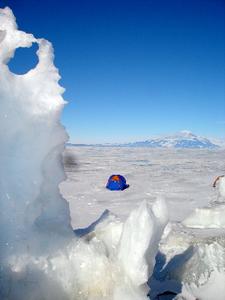
1. Not a bad scene to wake up to. One of our sleeping tents, as viewed from behind the pressure ridge. Mt. Discovery is in the background.

2. Kathy puts on her dive gear.

3. Looking down the dive hole.

4. Creative seiving using the hole that has warmer water from the Hotsy.

5. A big polychaete worm. Yum!
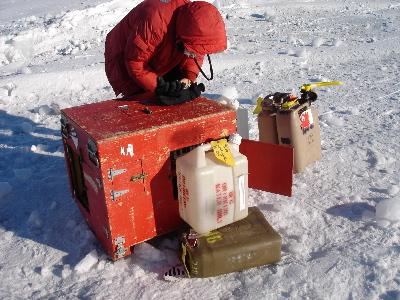
6. Warming up the drinking water with the exhaust from the generator.
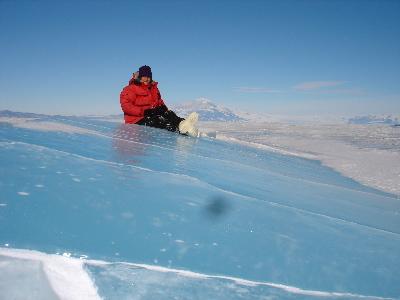
7. On top of the blue mound of ice.

8. A cool formation in pressure ridge ice. There are beautiful shapes like this everywhere; you could spent weeks just looking at them.
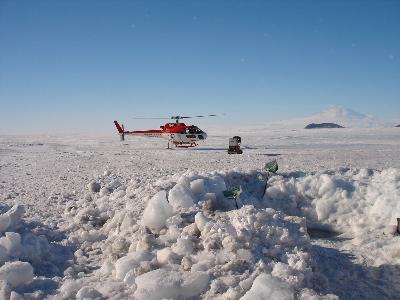
9. The helo arrives and lands near the Hotsy, which it will be carrying back to McMurdo.
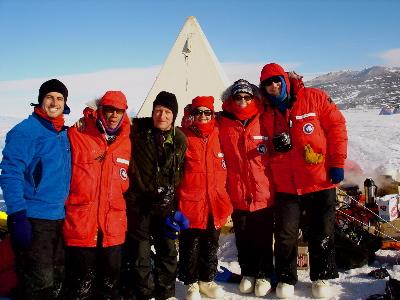
10. Stacy Kim's dive team at Cape Chocolate camp. From left: Andrew Thurber, Stacy Kim, Bob Zook, Kathy Conlan, Jennifer Fisher, Mike Donnellan. Stacy and Bob are still a little frozen after their dive!
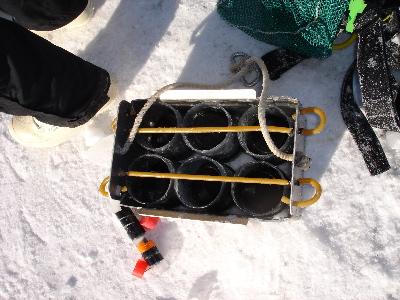
3. The rack carried by divers when coring. The rack carries six cores for samples, as well as smaller tubes for samples that will undergo chmical testing.
Contact the TEA in the field at
.
If you cannot connect through your browser, copy the
TEA's e-mail address in the "To:" line of
your favorite e-mail package.
|
